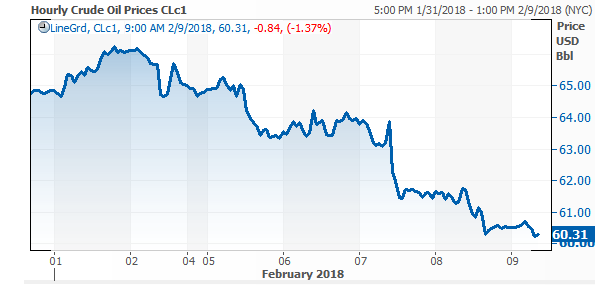
EIA Raises Crude Oil Price Forecast for 2018
Editor’s Note: Against a backdrop of plummeting prices, the EIA this week raised its price forecast for 2018 by $3. The EIA tends to use a very conservative forecasting method, so most major investment banks have price forecasts $5-10 higher than the EIA. Given their conservatism, the increase in the 2018 forecast is significant; not for the dollar amount forecast, but as a directional indicator that fundamentals remain strong.
EIA’s February Short-Term Energy Outlook (STEO) raises forecast crude oil prices in 2018 by nearly $3 per barrel (b) compared with the previous STEO. Average monthly Brent prices have increased for seven consecutive months, and, on January 11, spot prices moved higher than $70/b for the first time since December 2014. EIA forecasts Brent spot prices will average about $62/b in both 2018 and 2019, compared with an average of $54/b in 2017. EIA expects West Texas Intermediate (WTI) crude oil prices to average $4/b lower than Brent prices in both 2018 and 2019 (Figure 1). The upward revision to 2018 prices results in higher U.S. crude oil production throughout the forecast. However, with relatively little production growth from members of the Organization of the Petroleum Exporting Countries (OPEC) and higher global consumption, the global oil balances remain largely unchanged from the forecast last month.
Crude oil prices have increased over the past seven months as oil inventories, both in the United States and globally, have fallen steadily. In January, oil prices may have received some support following the OPEC monitoring committee meeting, where some oil ministers suggested extending the production cut agreement in some form beyond the currently scheduled expiration at the end of 2018.
Rapid declines in Venezuelan crude oil output are also likely contributing to higher crude oil prices. Average U.S. imports of crude oil from Venezueladeclined to less than 0.4 million barrels per day (b/d) for the four weeks ending January 26, approaching the lowest level in decades.
EIA estimates that U.S. crude oil production averaged 10.2 million b/d in January 2018, up 100,000 b/d from December 2017. EIA estimates that total U.S. crude oil production averaged 9.3 million b/d in 2017 and will average 10.6 million b/d in 2018, which would mark the highest annual average U.S. crude oil production level, surpassing the previous record of 9.6 million b/d set in 1970. EIA forecasts that 2019 crude oil production will average 11.2 million b/d.
OPEC total liquids production is expected to grow modestly through the forecast period, averaging 39.4 million b/d in 2018 and 39.9 million b/d in 2019. As a result, EIA estimates that global inventories will build by 0.2 million b/d in both 2018 and 2019, indicating that global markets are largely in balance.
Although EIA expects oil prices to decline in the first half of 2018, the timing and magnitude of price moves are uncertain. Global economic developments and geopolitical events in the coming months have the potential to push oil prices higher or lower than the current STEO price forecast. Uncertainty remains regarding the adherence to and duration of the OPEC and non-OPEC production cuts. Another key unknown in the oil market is the continued dynamism of the U.S. shale sector and how it responds to recent oil price increases with regard to capital outlays and potential input costs escalation. Although the pace of economic growth is forecast to quicken this year, there are both downside and upside risks to that forecast, and significant deviations could influence oil prices.
This article is part of Crude
Tagged:
MARKET CONDITION REPORT - DISCLAIMER
The information contained herein is derived from sources believed to be reliable; however, this information is not guaranteed as to its accuracy or completeness. Furthermore, no responsibility is assumed for use of this material and no express or implied warranties or guarantees are made. This material and any view or comment expressed herein are provided for informational purposes only and should not be construed in any way as an inducement or recommendation to buy or sell products, commodity futures or options contracts.







